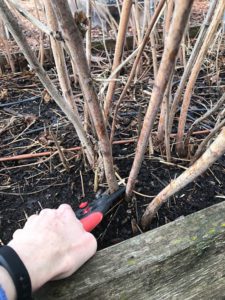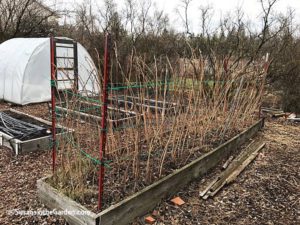How to Prune Raspberry Canes

 Ugh. I could’ve sworn I pruned our raspberry canes last fall, but as you can see from the photo to the left, I most definitely didn’t! Fortunately, it can be done in late winter/early spring, so no harm done. Since this task might seem puzzling to some folks, I thought it would be helpful to explain how to prune raspberry canes.
Ugh. I could’ve sworn I pruned our raspberry canes last fall, but as you can see from the photo to the left, I most definitely didn’t! Fortunately, it can be done in late winter/early spring, so no harm done. Since this task might seem puzzling to some folks, I thought it would be helpful to explain how to prune raspberry canes.
For decades, I’ve always pruned raspberry canes in the fall. A few years ago, I heard that it can be better to wait until late winter/early spring because if the canes still have leaves in the fall when you are hoping to prune them, those leaves are still producing “food” for the plants’ roots; in that case, they should be left alone. Maybe that’s why I was waiting till now to prune them, although I honestly haven’t decided if it makes much of a difference.
OK, so let’s get right to it… Oh, and remember that you can click on any of the photos to view a much larger, and more detailed, image.
First, I’m going to explain the process for pruning raspberries that bear a single crop per year. In our garden, those are the red ‘Canby’ variety. There are also raspberries that bear in the fall, and then again the following summer. We grow ‘Fall Gold’ which bears twice. I’ll write about that technique near the bottom of this post.
I’ve been mentioning the word “canes” — so what exactly are those? A cane is the stalk that has leaves and (at some point) berries on it. But there are TWO types of canes: primocanes and floricanes. Primocanes are new canes that only grow leaves the first year; they do NOT bear that year. Floricanes are actually the previous year’s primocanes; not only will they have leaves, but they’ll also bloom and bear fruit. Why is this important?
 Well, put bluntly, if you cut back ALL of your canes every year, you will never get any berries! Instead, you only want to cut back the canes that bore fruit. If you look at the photo to the left, this is what a floricane looks like at the end of the season. Notice how it has small side branches, and you might even be able to see the stems that the berries were pulled off of when I harvested them last summer. Those are the canes that you will cut down to the ground. (see below)
Well, put bluntly, if you cut back ALL of your canes every year, you will never get any berries! Instead, you only want to cut back the canes that bore fruit. If you look at the photo to the left, this is what a floricane looks like at the end of the season. Notice how it has small side branches, and you might even be able to see the stems that the berries were pulled off of when I harvested them last summer. Those are the canes that you will cut down to the ground. (see below)
Leave all of the primocanes — which don’t have any side branches, by the way — alone! Well, aside from perhaps trimming the height of them back to about 5 or 6 feet tall. But that’s all you’ll do with them.
 The other thing I like to do as I’m working my way through the pruning process is to remove any really wimpy-looking canes that don’t have nice upright growth. They really aren’t worth keeping in the berry bed because they won’t amount to much. I know that sounds harsh, but it’s true! (see photo to right)
The other thing I like to do as I’m working my way through the pruning process is to remove any really wimpy-looking canes that don’t have nice upright growth. They really aren’t worth keeping in the berry bed because they won’t amount to much. I know that sounds harsh, but it’s true! (see photo to right)
Once you’ve removed all of the floricanes that have already produced, you’ll be amazed at how tidy your raspberry bed looks:
How to Prune Raspberries that Produce Two Crops (i.e., ‘Fall Gold’)
As I mentioned at the top, we grow ‘Fall Gold’ raspberries, which are absolutely wonderful. They’re also really pretty, so they make a nice addition to tarts or fruit salads. Although I love just popping those warm, sweet berries into my mouth while standing out in the garden!
The interesting thing about this type of berry is that they will produce a crop in the fall near the top of the cane. This might lead you to think you can then trim it down to the ground, but if you do that, you’ll eliminate their second crop the following summer. And you don’t want to do that! The second crop is borne lower on the canes. So here’s what I do:
 I trim off the upper section of canes that you can see had berries on them and leave the rest of each cane in place. What you should see when you trim off the tops is green tissue in the middle of the cane (see photo to right). I realize this isn’t a great photo but you get the idea of what you’re looking for.
I trim off the upper section of canes that you can see had berries on them and leave the rest of each cane in place. What you should see when you trim off the tops is green tissue in the middle of the cane (see photo to right). I realize this isn’t a great photo but you get the idea of what you’re looking for.
If, however, you see brown tissue, that cane is dead and done, which means you can trim it down to the ground. But I always like to err on the side of caution by just trimming off the tops first to see which ones still have green tissue in the center of the canes because I know those will give me a second crop in the summer.
I hope this makes sense. As always, if you have questions, don’t hesitate to contact me at Susan@SusansintheGarden.com.


